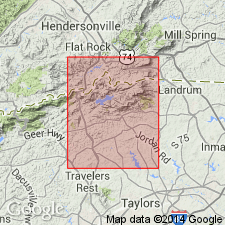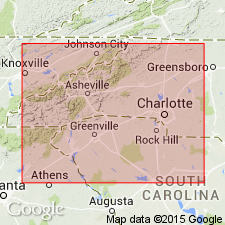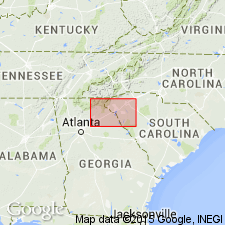
- Usage in publication:
-
- Caesars Head Quartz Monzonite*
- Modifications:
-
- Named
- Dominant lithology:
-
- Quartz monzonite
- Granite
- Granodiorite
- AAPG geologic province:
-
- Piedmont-Blue Ridge province
Summary:
The Caesars Head Quartz Monzonite is here named in SC and NC[?] for several irregularly shaped bodies of granitic rock that occupy 500 sq mi in the southeastern part of the Knoxville 2 degree quad. Biotite quartz monzonite and biotite granodiorite invade a terrane of older paragneiss and schist in the Piedmont. Resembles the less foliated phase of Henderson Gneiss. Age is younger than late Precambrian and at least as old as Carboniferous.
Source: GNU records (USGS DDS-6; Reston GNULEX).

- Usage in publication:
-
- Caesars Head Granite*
- Modifications:
-
- Revised
- Redescribed
- Dominant lithology:
-
- Granite
- AAPG geologic province:
-
- Piedmont-Blue Ridge province
Summary:
The Caesars Head Quartz Monzonite is here redefined as the Caesars Head Granite (to conform with IUGS classification of Streckeisen, 1973) of the Table Rock Plutonic Suite (this usage for SC only). The Table Rock Granite of Sloan (1907, 1908) and the Beverly Granite Gneiss of Cazeau and Brown (1963), refer to the same rock body and are here abandoned. The Caesars Head consists of banded to nonbanded biotite granitoid gneiss or gneissic granitoid, ranging in composition from monzogranite to granodiorite. Discontinuous black, biotite-rich bands alternating with white biotite-poor bands are common and typically folded. Interlayered and cross-cutting bodies of foliated, fine-grained, garnet-bearing muscovite-biotite granite occur locally. Age is Early Silurian or perhaps Ordovician, based on Rb-Sr whole rock ages.
Source: GNU records (USGS DDS-6; Reston GNULEX).

- Usage in publication:
-
- Caesars Head Granite*
- Modifications:
-
- Areal extent
- Geochronologic dating
- AAPG geologic province:
-
- Piedmont-Blue Ridge province
Summary:
Caesars Head Granite geographically extended to GA. Age is Ordovician(?) to Early Silurian based on preliminary discordant 206Pb-207Pb age of zircons of about 435 Ma (T.W. Stern and J.W. Horton, Jr., unpub. data).
Source: GNU records (USGS DDS-6; Reston GNULEX).
For more information, please contact Nancy Stamm, Geologic Names Committee Secretary.
Asterisk (*) indicates published by U.S. Geological Survey authors.
"No current usage" (†) implies that a name has been abandoned or has fallen into disuse. Former usage and, if known, replacement name given in parentheses ( ).
Slash (/) indicates name conflicts with nomenclatural guidelines (CSN, 1933; ACSN, 1961, 1970; NACSN, 1983, 2005, 2021). May be explained within brackets ([ ]).

